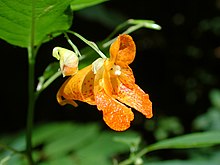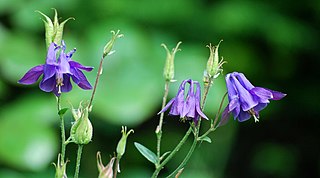
Aquilegia is a genus of about 60–70 species of perennial plants that are found in meadows, woodlands, and at higher altitudes throughout the Northern Hemisphere, known for the spurred petals of their flowers.

Heliconia is a genus of flowering plants in the monotypic family Heliconiaceae. Most of the 194 known species are native to the tropical Americas, but a few are indigenous to certain islands of the western Pacific and Maluku in Indonesia. Many species of Heliconia are found in the tropical forests of these regions. Most species are listed as either vulnerable or data deficient by the IUCN Red List of threatened species. Several species are widely cultivated as ornamentals, and a few are naturalized in Florida, Gambia, and Thailand.

Impatiens is a genus of more than 1,000 species of flowering plants, widely distributed throughout the Northern Hemisphere and the tropics. Together with the genus Hydrocera, Impatiens make up the family Balsaminaceae.

Impatiens glandulifera, Himalayan balsam, is a large annual plant native to the Himalayas. Via human introduction it is now present across much of the Northern Hemisphere and is considered an invasive species in many areas. Uprooting or cutting the plants is an effective means of control.

Aquilegia canadensis, the Canadian or Canada columbine, eastern red columbine, or wild columbine, is a species of flowering plant in the buttercup family Ranunculaceae. It is an herbaceous perennial native to woodland and rocky slopes in eastern North America, prized for its red and yellow flowers. It readily hybridizes with other species in the genus Aquilegia.

Aesculus flava, also known commonly as the common buckeye, the sweet buckeye, and the yellow buckeye, is a species of deciduous tree in the subfamily Hippocastanoideae of the family Sapindaceae. The species is native to the Ohio Valley and Appalachian Mountains of the Eastern United States. It grows in mesophytic forest or floodplains, generally in acid to circumneutral soil, reaching a height of 20m to 48m.
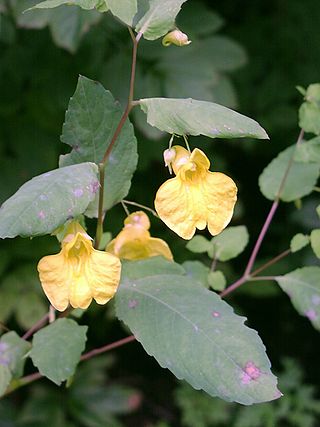
Impatiens noli-tangere is an annual herbaceous plant in the family Balsaminaceae found in damp places in Europe, Asia and North America. The yellow flowers are followed by pods which forcefully explode when ripe, ejecting the seeds for some distance.

Impatiens balsamina, commonly known as balsam, garden balsam, rose balsam, touch-me-not or spotted snapweed, is a species of plant native to India and Myanmar.

Impatiens pallida, with the common names pale jewelweed, pale touch-me-not, or yellow jewelweed, is a flowering annual plant in the family Balsaminaceae native to Canada and the United States. It grows in moist to wet soils, generally alongside the closely related Impatiens capensis, producing flowers from midsummer through fall.

Impatiens sakeriana is a perennial species of flowering plant in the family Balsaminaceae. It is native to Cameroon and Equatorial Guinea and grows in mountain forest understory habitat at elevations up to 3000 meters. I. sakeriana is most often cited for its role in sunbird pollination. It can be locally common in parts of its range, but its habitat is threatened by agriculture.
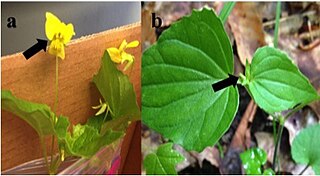
Chasmogamy is the type of plant reproduction in which the flowers open up, enabling cross-pollination. This is in contrast to cleistogamy, in which the flowers stay closed and self-pollinate.

Impatiens parviflora is a species of annual herbaceous plants in the family Balsaminaceae, native to some areas of Eurasia, naturalized elsewhere and found in damp shady places. Impatiens parviflora can grow in sandy, loamy, and clay soils and prefer moist soil.

Chamaecrista fasciculata, the partridge pea, is a species of legume native to most of the eastern United States. It is an annual which grows to approximately 0.5 meters tall. It has bright yellow flowers from early summer until first frost, with flowers through the entire flowering season if rainfall is sufficient.

Impatiens balfourii is a species of the genus Impatiens known by the common names Balfour's touch-me-not, Kashmir balsam, and poor man's orchid. It belongs to the family Balsaminaceae.

Lilium occidentale is a rare North American species of lily known by the common name western lily. Its species name 'Occidentale' means 'westernmost' and refers to its location along the West Coast. It is native to northwestern California and southwestern Oregon. It grows in coastal prairie habitat, swamps and stagnant bogs with Drosera species, bluffs and sandy cliffs, and seaside spruce forests. This rare wildflower is limited in distribution and directly endangered by a number of environmental factors. It is a federally listed endangered species and it is listed as endangered by the states of California and Oregon.

Impatiens sodenii is a species of flowering plant in the family Balsaminaceae known by the common names poor man's rhododendron, Oliver's touch-me-not, and shrub balsam. It is native to Kenya and Tanzania, and widely cultivated as an ornamental plant.
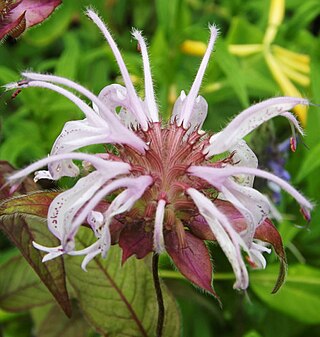
Monarda bradburiana, the eastern beebalm or Bradbury's beebalm, is a species of perennial flowering plant in the mint family, Lamiaceae, that is native to much of the southeastern United States.

A nectar spur is a hollow extension of a part of a flower. The spur may arise from various parts of the flower: the sepals, petals, or hypanthium, and often contain tissues that secrete nectar (nectaries). Nectar spurs are present in many clades across the angiosperms, and are often cited as an example of convergent evolution.
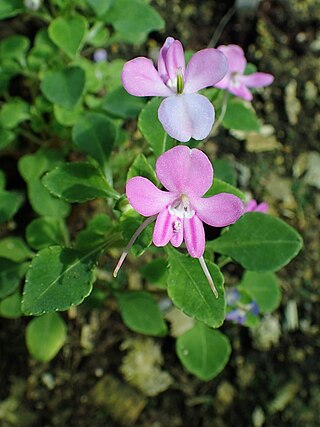
Impatiens pseudoviola, commonly known as the jewelweed and touch me not, is a species of flowering plant in the family Balsaminaceae, native to Kenya and Tanzania.

Impatiens aurella, also known as the Idaho jewelweed, mountain jewelweed, varied jewelweed, or pale yellow touch-me-not, is a species of flowering plant in the family Balsaminaceae. It is found in northwest North America up through British Columbia, Canada. It produces a yellow-orange flower during the blooming months of late June/early July through September. The plant is an annual herb that grows to just over 1 m tall. As a member of the genus Impatiens it is also a touch-me-not, a herbaceous plant that has a ripe seed capsule that will explode. The flowers are considered toxic, and should not be ingested. Once cultivated, the plant has medicinal properties to help in the treatment of warts, ringworm, nettle stings, and poison ivy rash. Additional research suggests yellow dye and shampoo for itchy scalps may be possible from this species.
